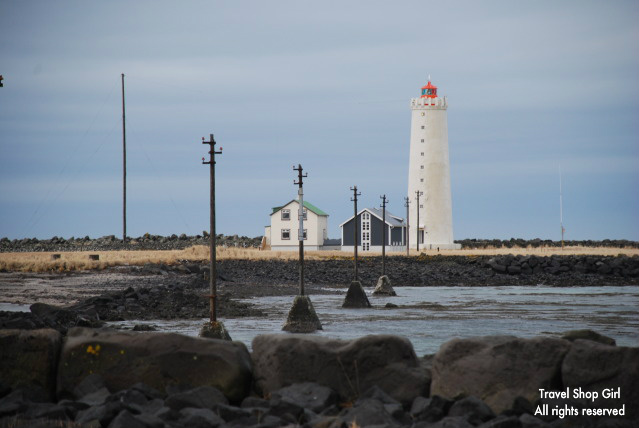
On my recent trip to Iceland, despite the cold and rainy weather we were having on Thursday, 2 February 2012, I was able to take a quick tour of Reykjavik. Part of my tour included hotel inspections, which I will cover in another post. Our trip began with our coach driver taking us out to Grótta Island. Never heard of it? Neither had I, but the history and incredible view was worthy of many, many pictures. This is the view from Grótta Island looking toward Mt. Esja. Here is some information about Grótta Island from Nordic Adventure Travel:
Island Grótta is the the point of the Seltjorn Peninsula of which the capital comprises the greatest part. The island is connected to the mainland by an isthmus, which is flooded during high tides, and many people walk across at low tides to enjoy the variety of the bird life and an occasional seal nearby. The land has been and still is subsiding rather quickly and those who have lived in the community for a long time have witnessed the gradual advance of the sea. In the immediate vicinity of the island is a popular golf course and a beacon for one of the runways of the Reykjavik Airport.

Because of its location, Iceland has been able to sustain itself by accessing a readily available and plentiful resource: fish. The fishing industry has always been extremely important to Iceland and before modern day freezing techniques were available, the Icelandic people would use drying racks to dry the fish, just like the ones seen here. Dried fish could last several years and simply required sun and wind to dry the fish to perfection. Dried fish would usually be prepared with butter and sometimes dulse (seaweed). From Icelandic Fisheries:
Stockfish was important to the export economies in Europe for more than a thousand years and was an important commodity for Iceland. Late in the 13th century stockfish became the most important export together with fish oil and weave in the economy of Iceland. In the later years, most of the Icelandic stockfish has been exported to Nigeria and Italy.
Although dried fish now only makes up about 2% of Iceland’s seafood export, it still remains part of the Icelandic diet. Icelanders eat mostly haddock, plaice, halibut, herring and shrimp. Before you ask if I have had hákarl, as seen hanging up to dry here, the answer is of course, “NO!” Hákarl is putrescent shark meat and is part of the þorramatur, the traditional seasonal Icelandic foods. It is known for its pungent taste and smell of ammonia. As such, eating hákarl is associated with hardiness and strength and you could easily see why. You have to be a special individual to want to eat hákarl willingly. I found a recipe on how to prepare hákarl here in case you would like to make and try some “rotten” or cured shark yourself.

The lighthouse on Grótta Island has an amazing presence in an otherwise barren landscape. Apparently, the city folks from Reyjkavik like to come out here and enjoy the bird watching and peacefulness of the area. If you wanted to spend an afternoon leisurely walking around and snapping pictures, this would be a great spot in which to do this. Here’s more information from Nordic Adventure Travel:
In earlier times a farm occupied the island and the lighthouse standing there was built in 1897. It was restored thoroughly in 1947 and has been maintained well since then. There were fishing outfits on the island as well, when the fisheries were based on open rowing boats. The volunteer rescue corps of the Seltjarnarnes community was named after one of the caretakers of the lighthouse, Albert Thorsteinsson (1910-1973).

Have you ever traveled somewhere and let out a gasp when you saw something for the first time? That’s what I did when I saw Mt. Esja for the first time. At 914 m (2,998.69 ft), Mt. Esja is the highest mountain in the vicinity of Reykjavík. Mt. Esja is not a single mountain, but a volcanic mountain range, made from basalt and tuff-stone. Regardless of what it’s made of or if it’s one or more mountains, it is a sight that should not be missed when visiting Iceland. I’m sure tourists see it when driving around, but whether or not they appreciate it, I don’t know. I do know that hikers and climbers like Mt. Esja and enjoy a hike up to the summits of Þverfellshorn (780 m) and Kerhólakambur (851 m). I would love to see the view from up there!
If you’re looking for an active vacation, I can’t express how much there is to do in Iceland and Mt. Esja is just one of them. If you’re not active, but have an appreciation for nature, Iceland is for you as well. In fact, I can’t think of anyone who wouldn’t like Iceland. Hey, I’m thinking that the Iceland Board of Tourism should call me, don’t you think? But seriously, Iceland is an active country with much to do, places to visit (like glaciers and waterfalls among other things), shopping, geothermal spas, great cuisine (minus maybe the hákarl), and the people are extremely welcoming. What other country is as hospitable as Iceland? Check out the Inspired by Iceland campaign where the Icelandic people are inviting tourists to spend time with them. Imagine attending a birthday party, grabbing a latte, sharing waffles, or getting a bedtime story by a local. They want us to visit Iceland and experience it as a local so what are you waiting for? I can’t wait to go back and believe me, I am looking right now trying to figure out a way to get back there soon.



